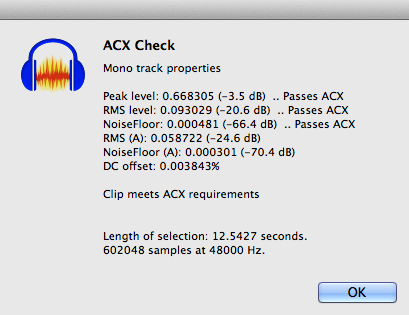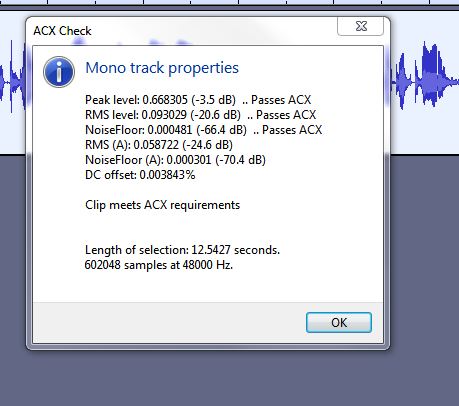There. That wasn’t too hard.

The specification for noise is -60dB, but it’s a good idea to pass it by at least -65dB (quieter).
There’s a little fudge built into Peak as well. The official specification is no louder than -3dB. The suite delivers -3.5dB (quieter). Nobody can hear a half-dB difference and that gets you past the MP3 conversion errors for file delivery.
I applied Audiobook Mastering Suite…

… from here…
https://wiki.audacityteam.org/wiki/Audiobook_Mastering
The forum instructions will tell you how to get all the tools if you’re missing any.
Mastering will only get you past the basic sound recording part of acceptance. You also have to pass Human Quality Control who will judge you on theater qualities such as stuttering and mouth noises. There’s no Audacity analysis tool for those, and you have to pass everything.
I see you’re already careful about not including punctuation marks other than -dash- and underscore. You should also be freely Exporting WAV files as safety backups. For example, Export a WAV file of a raw chapter reading, fluffs and all. If Audacity goes into the mud while you’re editing, it’s good not to have to drag out the microphone and read it all again. Just open a copy of the protection backup.
Same when you’re done editing and processing. Export a WAV (Microsoft)16-bit of the final chapter and only then, make the 192 quality MP3 for ACX.
You can send a short test to ACX.
https://forum.audacityteam.org/t/how-to-send-a-test-to-acx/49588/1
They won’t analyze your studio, so don’t expect a spirited dialog with them.
As a side editorial opinion, I would try to read so it doesn’t sound like you have a gun to your head. You are a performer and you have to be able to be different people on cue. There are readers who go down the book and make up voices for each character. That depends on the book, but it’s a good idea.
Also remember ACX loves consistency. Once you start a book and it’s going well Do Not Change Anything. The start and end of each chapter and the start and end of the book all have to match.
Koz


